"Once you go on the canoe, because it's so small, you try to make it like one family."--That is the sailing philosophy of Snake Ah Hee, a 16-year veteran crew member of the Hokule'a. For a dozen plus people to live happily and harmoniously in tight living quarters and over thousands of miles, he and other crew members know the right mental a nd emotional attitude is key.
Living space is tight--the deck is about 40 feet long and 10 feet wide, totaling 400 square feet.
Sleeping quarters are even more cramped and less than comfortable. The sleeping compartments run the length of both sides of the deck and are covered with canvas. Individual spa ces measure about 6 feet in length and 3 feet across, usually with two crew members assigned to each space. One person sleeps while the other stands watch. Personal belongings are stowed here, with each crew member allowed one 48 quart cooler. Beds consist of a board placed over the coolers, covered by a sleeping pad.
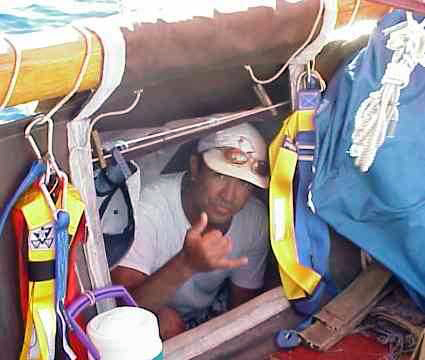
Kawika Crivello looking out from the sleeping quarters
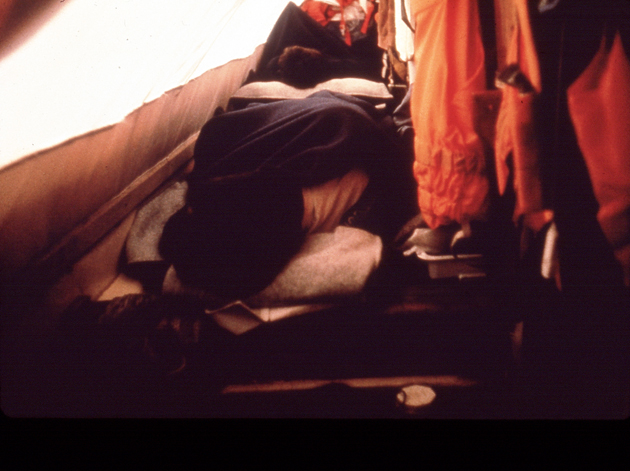
Inside the sleeping quarters
Bathroom facilities, located on either side of the canoe, take things right down to basics.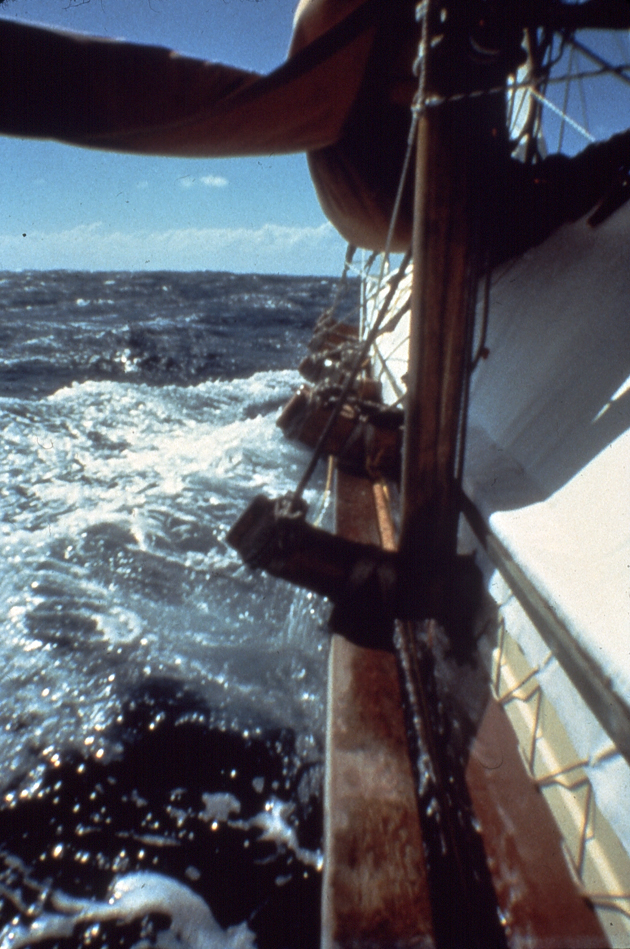
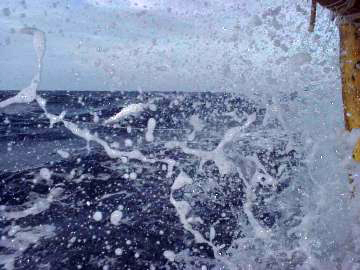
Bathing is done either forward or aft on the canoe. Forward, you sit in a net slung between the two canoe hulls. Aft, you bathe in an open compartment, pulling salt water up in a 5 gallon bucket. You use a special sea soap, which makes bathing in salt water actually refreshing.
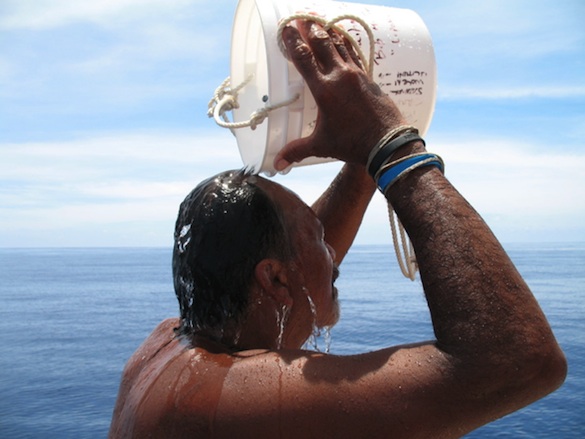
Cooking is done in the center of the canoe. The galley, or kitchen, is a two burner propane gas stove housed in a metal box. By necessity, most of the food on board comes out of a box or can, supplemented by whatever fresh fish the crew can catch. Each vo yage has a designated fisherman, who puts his trolling lines out off the back of the canoe every morning.

Pancakes and eggs for breakfast.
On long trips, food is much more than a source of nutrition and sustenance. Mealtime is one of the few times during the day that the entire crew is together on deck. On long monotonous days, meals are a highlight. When the weather is cold and rainy, a hot meal can do wonders for morale.The canoe carries bottled fresh water for cooking and drinking. On an estimated 30 day voyage the canoe will carry enough water for 40 days at sea. If water supplies become too low, the captain can order that water be rationed. Crew members also store rai n water for cooking and bathing.
It takes a lot of work to sail Hokule'a and everyone is assigned a job. Crew members are divided into watches, teams of people who work specific shifts. On the normal three-team watch system, each person works a four hour shift twice a day, with eight hours off in between. If you are on the 2 to 6 watch, you'll work from 2 to 6 in the morning and the again from 2 to 6 in the afternoon. In bad weather, the crew may go to a two-team watch system.
The watch on duty is responsible for maintaining the canoe, working the steering paddles, handling the sails and keeping water out of the compartments. At the start of watch the crew runs through a safety checklist to ensure that Hokule'a is in optimum sailing condition. Each watch has a captain responsible for supervising the others on his or her team.
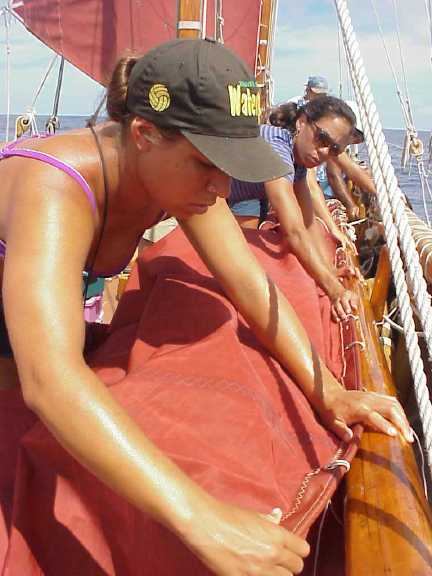
Changing Sails. Tahiti-Hawai‘i 2000.
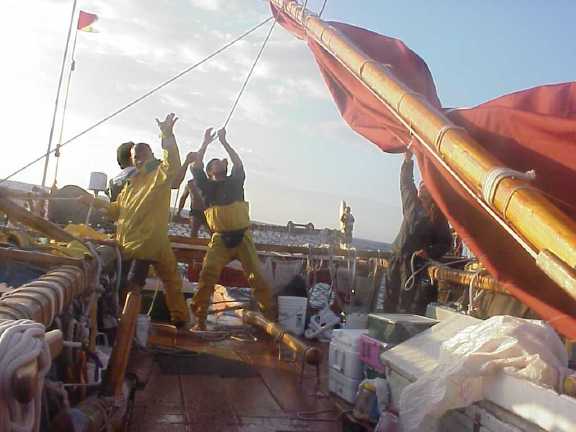
Lowering the rig to prepare for a squall. Tahiti-Hawai‘i 2000.
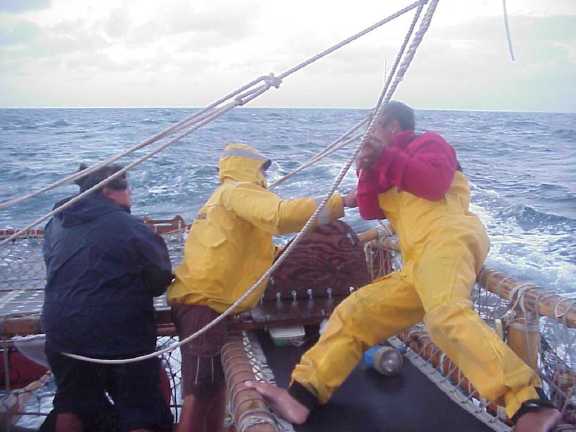
Tightening sheets in stormy weather. Tahiti-Hawai‘i 2000.
When crew members are off watch, they rest, read, write in their journals, wash laundry, make music or simply relax and enjoy being out at sea. Time can pass slowly although this is the exception rather than the rule. Being away from home for extended periods of time, the crew does experience ups and downs and homesickness is not uncommon, especially for the new crew members.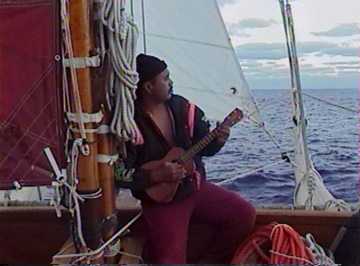
Mona Shintani on his uke. Hiva Oa to Pitcairn, 1999.
Older crew members have the responsibility to make sure that everyone gets through these low points.Roles and Duties of Hokule‘a Crew Members
Sailing Hokule'a is a rigorous job and it requires the participation of all crew members on board. To ensure that the canoe sails safely and efficiently, each person fills a specific role. Jobs vary from that of the navigator, to those crew members whose primary responsibility is documentation of the voyage for historical purposes. Providing they fill the job requirements, both men and women can hold the various positions described below.The person who carries the overall responsibility for the canoe and crew is the sailmaster. While he serves primarily in an advisory capacity, it is the sailmaster who has the final say on the canoe's sailing strategy and course and on all other operations of the canoe. He works in consultation with the navigators and captain.
The navigator, who is usually the same person as the sailmaster, determines the canoe's course, sets the sailing strategy, and determines the direction in which the crew will sail Hokule'a. He must stay oriented at all times, and this means that generally he is assigned no other duties aboard the canoe. In order to keep track of the canoe's direction, the navigator stays awake 20 hours a day, seated on a platform at the aft of the canoe. The navigator gives direction to the crew through the captain. The crew on watch steers the canoe under the direction of the navigator and captain, working the steering sweep and paddles and trimming the sails to stay on course while maintain the maximum speed.
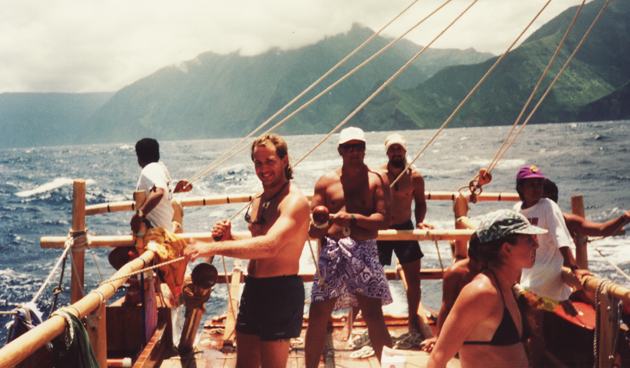
The captain's primary responsibility is the safe sailing of Hokule'a and this encompasses everything from ensuring that a capable well-trained crew is on board to the physical maintenance of the canoe. Much preparation is done before the crew and canoe ever leave shore and this is done under the captain's direction. In consultation with the other officers, the captain schedules work parties for preparing the canoe to sail. Re-lashing canoe parts, mending sails, cleaning and painting Hokule'a's hulls are just some examples of the kinds of work done before sailing.
Another big job is loading the canoe with food, water, and safety gear required on voyages. Again, it is the captain's responsibility to ensure that this is done properly.
At sea, the captain executes all decisions relative to sailing. Once the navigator sets the sailing strategy, it is the captain who directs the crew to hoist, drop or change sails and he determines which steering paddles to use. He is responsible for coo rdinating activities with the escort vessel and providing a daily work schedule for the watch captains. The captain holds overall responsibility for maintaining the canoe's inventory, and he decides when and if to ration food and water. When approaching l and, the captain handles most administrative matters, such as dealing with customs officials and maintaining the canoe's security while it is moored.
The watch captains direct those crew members assigned to their watch or work shifts, carrying out instructions relayed by the captain. The watch captain is responsible for ensuring that his crew is up and on duty in a timely fashion, assigning specific st eering positions to his crew and directing rotations through the various positions, going through the safety check list, and maintaining his watch log. He is responsible for maintenance of the canoe during his watch, including cleaning up after meals. Add itionally, the watch captain is responsible for monitoring the safety, health and morale of his crew.
Other tasks are assigned to crew members and carried out in addition to standing watch. The medical officer, usually a certified doctor, is aboard Hokule'a for each long voyage. His primary responsibility is the health of the crew. It is the medical offic er's responsibility to ensure that the canoe is equipped with all medications and medical supplies needed for a long journey. When the canoe is in foreign ports, the medical officer is also responsible for attending to the crew's health and medical needs on shore.
The radio operator handles all radio transmissions between Hokule'a, and the escort vessel and between the canoe and land. He maintains an accurate log of all radio traffic, and is responsible for the upkeep of the radio equipment.
A designated carpenter oversees all repairs done on the canoe. He also maintains the tool inventory. An assigned electrician maintains all electrical systems.
The cook plans the canoe's menus, maintains iventory of food supplies, and does most of the cooking. While this may not seem like an important job, the ability of the cook is directly related to the morale of the crew as meals are the highlight of each da y. Good nutrition is also an important factor in maintaining the health of the crew.
The quartermaster is responsibile for provisioning the canoe--loading food, water and all needed supplies, and for maintaining Hokule'a's inventory. While this is not an on board job, it is critical to the safe and efficient sailing of the canoe. Weight m ust be evenly distributed for optimum sailing.
Fishing off of the canoe is not a leisure time activity, but an actual designated job, and one crew member is responsible for setting and bringing in fishing lines each day and for landing all catches. Fresh fish provide an important food source at sea.
Documentors keep historical records of the voyage by various means including writing, video and audio taping.
The safety officer is responsible for all safety and emergency systems and equipment. Life jackets, life preservers, flares and fire extinguishers are just some examples of the gear the canoe carries. In addition, all crew members must be trained in man o verboard and fire procedures.
Crew responsibilities are exactly the same as the watch captain, with the exception of the administrative duties. Off watch, crew members main obligation is to keep out of the way of those on duty.
Leisure time is spent in a variety of ways including resting, reading, writing, and taking care of personal chores (laundry, cleaning out compartments etc.). In the event of bad weather or an emergency and an all hands on deck call, all of the crew member s are expected to work.
All jobs on the canoe, no matter how routine they may seem, are important to the overall safe sailing of Hokule'a. A crew member's most critical responsibility is to realize that his crewmates depend upon him to carry out his assigned duties, and to work well as part of a team.